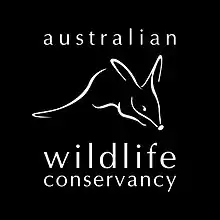Australian Wildlife Conservancy
The Australian Wildlife Conservancy (AWC) is an Australian independent, non-profit organisation, working to conserve threatened wildlife and ecosystems in Australia. This is principally achieved through the acquisition of extensive areas of land on which to establish conservation reserves ("sanctuaries") or by entering into partnerships with government and Indigenous groups to manage landscapes for effective conservation. AWC currently manage 28 sanctuaries for wildlife conservation that cover over 4.8 million hectares of land across Australia.[1]

Australian Wildlife Conservancy operate under a unique model for conservation, using science (predominantly biodiversity survey work and targeted research) to inform on-ground land management, such as control of fire, feral animals and weeds.[1] There is a strong focus across the organisation at placing time and resources in the field for wildlife conservation: consequently, about 80% of all staff are based in the field, and a minimum of 84% of all expenditure goes to field-based conservation programs.[1]
Most funding comes from private support in the form of tax-deductible donations from the public[1] as well as some government grants for particular purposes, such as from the Australian Government’s National Reserve System Program.
Australian Wildlife Conservancy was founded in response to Australia's mammal extinction crisis.[1] Over a third of the world's extinctions from the last 400 years have been from Australia, and Australia has already lost 31 species of mammal.[2][3] Many of these extinctions were entirely preventable with effective conservation measures in place.[2] The 2016 State of the Environment report suggests that while Australia is incredibly rich in its biodiversity, despite legislation at all state and federal levels, it continues to suffer from unprecedented decline.[4] In response, AWC protect a diverse array of habitats across a large network of sanctuaries, to protect 88% of Australia's bird species, 72% of mammals and 54% of Australia's frog and reptile species.[1]
In June 2007 AWC announced the establishment of a corporate partnership with Optus.[5]
As of May 2019, the most recent sanctuary is Bullo River which covers over 160, 000 hectares in the north-west corner of Northern Territory, near the mouth of the Victoria River.[6] This is a unique partnership between a working pastoral property and a conservation sanctuary to generate outcomes for both wildlife and cattle.[6] The landscape here is typical of the Eastern Kimberley, dominated by Keep River sandstone formations with rocky gorges, lush riverside vegetation and expansive tropical savannah woodland.[6] Inventory biodiversity surveys have already identified several important species of rare and threatened wildlife including the Gouldian finch (Erythrura gouldiae) and wyulda or scaly-tailed possum (Wyulda squamicaudata).[6]
History
The origin of the organisation lies in a 1991 land purchase (of what is now Karakamia Sanctuary) by AWC’s founder, Martin Copley. He established the sanctuary, constructed a feral-proof fence, cleared the area of feral animals and started re-introducing threatened mammals into this area. Karakamia is still open for public spotlight tours where you can see small mammals such as the critically endangered woylie or brush-tailed bettong (Bettongia penicillata), Tammar Wallaby (Macropus eugenii), quenda and common brushtail possum.[7] In 2001 the AWC became a public charitable organization.[5]
In 2002 The AWC agreed to acquire four sanctuaries, Buckaringa, Dakalanta, Scotia and Yookamurra, for A$5.2m from Earth Sanctuaries Ltd (ESL), the company founded by Dr John Wamsley.[8]
AWC Sanctuaries
|
|
|
References
- "Home". AWC - Australian Wildlife Conservancy. Retrieved 11 June 2019.
- Cox, Lisa (12 February 2018). "'A national disgrace': Australia's extinction crisis is unfolding in plain sight". The Guardian. ISSN 0261-3077. Retrieved 11 June 2019.
- "Australia's worsening animal extinction crisis is 'inevitable'". NewsComAu. 4 April 2019. Retrieved 11 June 2019.
- Report, Australia State of the Environment (12 June 2019). "Biodiversity". Australia State of the Environment Report. Retrieved 11 June 2019.
- Australian Wildlife Conservancy: About AWC Archived 26 December 2007 at the Wayback Machine
- "Bullo River Station". AWC - Australian Wildlife Conservancy. Retrieved 11 June 2019.
- "Karakamia". AWC - Australian Wildlife Conservancy. Retrieved 11 June 2019.
- AWC Media Release, 20 April 2002: A Win for Australian Conservation - Australian Wildlife Conservancy to acquire sanctuaries from Earth Sanctuaries Ltd."Archived copy" (PDF). Archived from the original (PDF) on 30 October 2007. Retrieved 2008-01-08.CS1 maint: archived copy as title (link) PDF downloaded 8 January 2008
- A biological survey of Faure Island, Shark Bay World Heritage property, Western Australia / edited by Jacqueline D. Richards and Barry Wilson. Perth, W.A. : Western Australian Museum, 2008. Records of the Western Australian Museum. Supplement, 0313-122X ; no. 75 "Australian Wildlife Conservancy, in collaboration with the Western Australian Museum, South Australian Museum and Western Australian Department of Environment and Conservation"--on title page